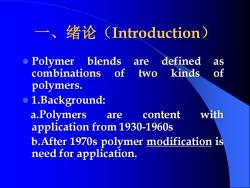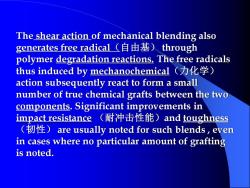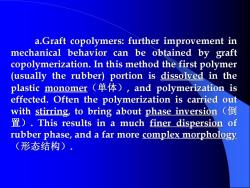海南大学:《高分子材料共混原理》课程教学课件(PPT讲稿)聚合物共混原理 Blending Princlple for Polymers(英文版)

聚合物共混原理(Blending principle for Polymers) Liaoshuangquan Ph.D
聚合物共混原理(Blending principle for Polymers) Liaoshuangquan Ph. D

一、绪论(Introduction) Polymer blends are defined as combinations of two kinds of polymers. ●1.Background: a.Polymers are content with application from 1930-1960s b.After 1970s polymer modification is need for application
一、绪论(Introduction) ⚫ Polymer blends are defined as combinations of two kinds of polymers. ⚫ 1.Background: a.Polymers are content with application from 1930-1960s b.After 1970s polymer modification is need for application

o 2.The aim of blending modification for polymer:(目的) a.Improving or enhancing final product some properties and gaining in high function. b.Simplification or Improvement in technology. Reducing compound cost
⚫ 2. The aim of blending modification for polymer:(目的) a. Improving or enhancing final product some properties and gaining in high function. b. Simplification or Improvement in technology. c. Reducing compound cost

3.Methods of mixing polymer pairs: (方法) a.Physical blending modification. b.Chemical blending modification
⚫ 3.Methods of mixing polymer pairs: (方法) a. Physical blending modification. b. Chemical blending modification

●4.Basic conception:(基本概念) The principal methods of mixing two kinds of polymer molecules include mechanical blending(机械共混物) 乎aft copolymerization(接枝共聚物) block copolymerization(嵌段共聚物) and interpenetration_of polymer networks(互穿网络共混物)】
⚫ 4. Basic conception:(基本概念) The principal methods of mixing two kinds of polymer molecules include mechanical blending(机械共混物), graft copolymerization(接枝共聚物), block copolymerization(嵌段共聚物), and interpenetration of polymer networks(互穿网络共混物)

a.Polymer blends:polymer blends may be defined as intimate mixtures of two kinds of polymers,with no covalent bonds_(共价键)between them. Historically, material prepared mn mechanical l blending usually contain several percent of Elastomer(弹性体) dispersed(分散)in a plastic matriⅸ(塑 料母体),the plastic component usually predominates(主导地位)
a. Polymer blends: polymer blends may be defined as intimate mixtures of two kinds of polymers, with no covalent bonds ( 共价键 ) between them. Historically, material prepared in mechanical blending usually contain several percent of Elastomer(弹性体) dispersed(分散) in a plastic matrix(塑 料母体), the plastic component usually predominates(主导地位)

The shear action of mechanical blending also generates free radical(自由基through polymer degradation reactions.The free radicals thus induced by mechanochemical(力化学) action subsequently react to form a small number of true chemical grafts between the two components.Significant improvements in mpact resistance(耐冲击性能)and toughness (韧性)are usually noted for such blends,even in cases where no particular amount of grafting is noted
The shear action of mechanical blending also generates free radical(自由基) through polymer degradation reactions. The free radicals thus induced by mechanochemical(力化学) action subsequently react to form a small number of true chemical grafts between the two components. Significant improvements in impact resistance (耐冲击性能)and toughness (韧性) are usually noted for such blends , even in cases where no particular amount of grafting is noted

a.Graft copolymers:further improvement in mechanical behavior can be obtained by graft copolymerization.In this method the first polymer (usually the rubber)portion is dissolved in the plastic monomer(单体),and polymerization is effected.Often the polymerization is carried out with stirring,to bring about phase inversion )This results in a much finer dispersion of rubber phase,and a far more complex morphology (形态结构)·
a.Graft copolymers: further improvement in mechanical behavior can be obtained by graft copolymerization. In this method the first polymer (usually the rubber) portion is dissolved in the plastic monomer(单体), and polymerization is effected. Often the polymerization is carried out with stirring, to bring about phase inversion(倒 置). This results in a much finer dispersion of rubber phase, and a far more complex morphology (形态结构)

a.Block copolymers:In block copolymers,in a two monomers mixing system,first one monomer polymerization and the individual components are joined at their ends.The most elegant procedure follows the "living polymer"anionic polymerization process (Henderson and Szwarc 1968).The unusual features of this reaction include simultaneous nucleation and uniform growth rates of all chains,and lack of termination reactions. After exhaustion of a first monomer the polymer chains remain alive,and addition of a second monomer result in a block copolymer of the form. A-(A)n-2-A-B-(B)m-2-B Where n and m are the degrees of polymerization of the A and B per units,respectively.More blocks can be added in the same manner,if desired
a.Block copolymers: In block copolymers, in a two monomers mixing system, first one monomer polymerization and the individual components are joined at their ends. The most elegant procedure follows the “living polymer” anionic polymerization process (Henderson and Szwarc 1968). The unusual features of this reaction include simultaneous nucleation and uniform growth rates of all chains, and lack of termination reactions. After exhaustion of a first monomer the polymer chains remain alive, and addition of a second monomer result in a block copolymer of the form. A-(A)n-2 -A-B-(B)m-2 -B Where n and m are the degrees of polymerization of the A and B per units, respectively. More blocks can be added in the same manner, if desired

a. Interpenetrating polymer networks (IPN's):this novel class of polymers,together with simultaneous )interpenetrating networks(SIN's)and interpenetrating elastomeric networks(IEN's)
a. Interpenetrating polymer networks (IPN’s): this novel class of polymers, together with simultaneous (同 时) interpenetrating networks(SIN’s) and interpenetrating elastomeric networks(IEN’s)
按次数下载不扣除下载券;
注册用户24小时内重复下载只扣除一次;
顺序:VIP每日次数-->可用次数-->下载券;
- 海南大学:《高分子材料共混原理》课程各章习题(无答案).doc
- 海南大学:《高分子材料共混原理》课程教学大纲 Blending Princlple for Polymers.doc
- 信阳师范大学:《材料科学基础》课程教学资源(PPT课件)第四章 非晶态结构与性质.pptx
- 信阳师范大学:《材料科学基础》课程教学资源(PPT课件)第六章 基本动力学过程——扩散.pptx
- 信阳师范大学:《材料科学基础》课程教学资源(PPT课件)第八章 腐蚀与氧化.pptx
- 信阳师范大学:《材料科学基础》课程教学资源(PPT课件)第五章 表面结构与性质.pptx
- 信阳师范大学:《材料科学基础》课程教学资源(PPT课件)第二章 晶体结构.pptx
- 信阳师范大学:《材料科学基础》课程教学资源(PPT课件)第九章 疲劳与断裂.pptx
- 信阳师范大学:《材料科学基础》课程教学资源(PPT课件)第三章 晶体结构缺陷.pptx
- 信阳师范大学:《材料科学基础》课程教学资源(PPT课件)第七章 材料制备中的固态反应.pptx
- 信阳师范大学:《材料科学基础》课程教学资源(PPT课件)第一章 材料引言(主讲:刘作冬).pptx
- 广西民族大学:金属材料工程专业课程教学大纲汇编(数学与物理学院,2012 年修订).pdf
- 曲阜师范大学:《新型功能材料》课程教学大纲.pdf
- 曲阜师范大学:《材料研究方法》课程教学大纲.pdf
- 曲阜师范大学:《无机非金属材料学》课程教学大纲.pdf
- 曲阜师范大学:《复合材料》课程教学大纲.pdf
- 曲阜师范大学:《催化剂表征》课程教学大纲.pdf
- 曲阜师范大学:《材料物理》课程教学大纲.pdf
- 曲阜师范大学:《材料科学基础》课程教学大纲.pdf
- 曲阜师范大学:《材料化学实验》课程教学大纲.pdf
- 《高分子材料共混原理》课程教学资源(PPT课件)第一章 绪论及聚合物共混的热力学.ppt
- 《高分子材料共混原理》课程教学资源(PPT课件)第二章 多组分聚合物的相态结构及其演变.ppt
- 《高分子材料共混原理》课程教学资源(PPT课件)第三章 聚合物共混体系界面形成及表征.ppt
- 《高分子材料共混原理》课程教学资源(PPT课件)第四章 聚合物共混体系的制备及设备.ppt
- 《高分子材料共混原理》课程教学资源(PPT课件)第五章 聚合物共混体系的力学性能.ppt
- 《高分子材料共混原理》课程教学资源(PPT课件)第六章 聚合物增韧改性.ppt
- 《高分子材料共混原理》课程教学资源(PPT课件)第七章 聚合物共混体系的流变性能及其它性能.ppt
- 长春工业大学:《金属工艺学》课程教学大纲 Metal Technology.pdf
- 新疆大学:《结晶学与矿物学》课程授课教案.pdf
- 新疆大学:《结晶学与矿物学》课程教学课件(PPT讲稿)第一章 结晶学概论.ppt
- 新疆大学:《结晶学与矿物学》课程教学课件(PPT讲稿)第二章 矿物的化学成分.ppt
- 福州大学:《材料现代分析方法》课程教学大纲 Moden analysis method of materials.pdf
- 福州大学:《材料现代分析方法》课程教学实验指导书(共四篇多个实验).doc
- 福州大学:《材料现代分析方法》课程教学资源(教案讲义)绪论.doc
- 福州大学:《材料性能学》课程教学大纲.pdf
- 《材料性能学》课程教学课件(PPT讲稿)材料在其他静载下的力学性能.ppt
- 南京林业大学:《包装材料学》课程教学资源(PPT课件)第一章 木材及木质复合包装材料.ppt
- 南京林业大学:《包装材料学》课程教学资源(PPT课件)第二章 纸和纸板包装材料.ppt
- 南京林业大学:《包装材料学》课程教学资源(PPT课件)第三章 塑料包装材料.ppt
- 南京林业大学:《包装材料学》课程教学资源(PPT课件)第四章 金属包装材料.ppt
